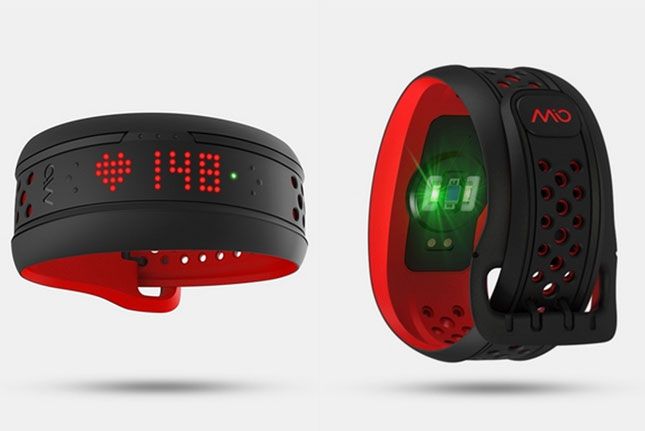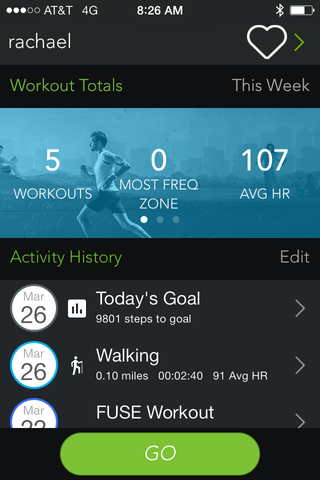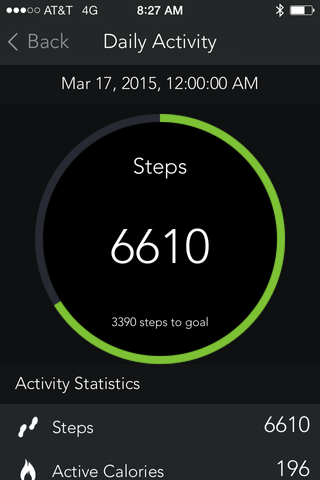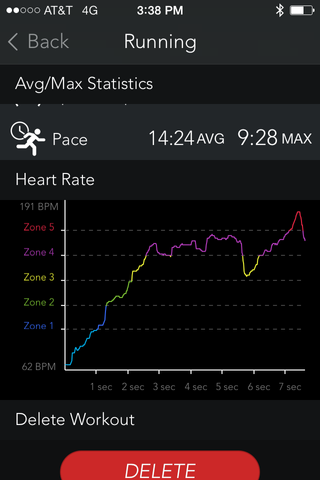Mio Fuse: Fitness Tracker Review

The Mio Fuse is a fitness tracker and training device from Mio Global — a company known for wrist-worn heart-rate monitors — that is very much intended for people who work out. The device includes an optical sensor to measure your heart rate during workouts, and will notify you when your heart rate has reached certain "zones." It also measures your workout's duration, distance, pace and speed, and even when you're not working up a sweat, it tracks total daily steps and calories burned.
At about $150, the Mio Fuse is on the higher end of the price range for fitness trackers, and it's the same price as the Adidas Fit Smart, which also features heart-rate-based training but does not track steps or calories.
Still, the Fuse does not include some features that have become standard in many fitness trackers, such as sleep tracking.
Overall Rating: 5.1/10
Although the Fuse is labeled as an activity tracker, it is more of a heart-rate monitor/training device that has a few fitness-tracking features tacked on. If you already work out regularly and are looking for a device that can monitor your heart-rate zones from your wrist, then the Fuse may work for you.
But if you are more of a fitness amateur, or want a device that provides motivation, I suggest looking elsewhere.
After testing out both devices, I think the Adidas Fit Smart is a better choice than the Mio Fuse, because (as I'll explain below) the Fit Smart lets you design your own training plan and calibrate your heart-rate zones, and it shows you if you are improving in your workouts by providing a score at the end of every workout. The Fuse does not offer any of these features.
Sign up for the Live Science daily newsletter now
Get the world’s most fascinating discoveries delivered straight to your inbox.
The Fit Smart also includes a heart-rate sensor made by Mio. Still, the Fuse is a very comfortable and accurate device.
Design/Comfort: 6.5/10
The Fuse is a fairly large device, with a screen that's 1.2 inches (3 centimeters) wide. But despite its size, I found the device to be very comfortable. It has a soft silicon strap that's adjustable. The device comes in two sizes: large and small/medium. But there's not much room for personalization with this device. Each size comes in only one color — aqua for the small, and red for the large. Plus, it's the underside of the strap that's colored, so it's hard to see the color when you're wearing it.
The Fuse doesn't have any buttons, but there are dot icons on either side of the screen that you tap to scroll through your stats. There are also dots on the top of the screen, which you hold down to take your heart rate and tap a second time to start a workout.
The screen has a bright-red LED display that's easy to read in most situations but is a little less readable in direct sunlight. The screen stays off most of the time, unless you tap it to view your time/stats. This means that if you're wearing the device as a watch, you have to tap it to see the time. In contrast, the Basis Peak, which also tracks heart rate, has a screen that is always on, so you only have to glance at your wrist to see the time. But there is a difference in battery life: The Fuse's battery lasts up to seven days with regular use, whereas the Peak's lasts a maximum of four days.
Another way the Fuse saves its battery is that it does not monitor your heart rate all day along (unlike the Peak and Fitbit Charge HR, which do track heart rate all day). The Fuse tracks your heart rate only during workouts. However, you can check your resting heart rate with the Fuse by pressing down on the dots at the top of the screen.
The Fuse is waterproof up to 30 meters (about 100 feet), so you can take it swimming.
User-Friendliness: 7/10

The Mio Fuse is meant to be paired (via Bluetooth) with the Mio Go app, which is available for the iPhone and Android devices. I was happy to discover that the syncing process was flawless. I have an older iPhone (4S), and some of the fitness trackers I've tested have had trouble pairing with it, but the Fuse did not.
The Fuse also syncs with some other smartphone apps, such as MapMyRun, and pairs with a number of GPS watches and bike computers.
During workouts, the Fuse gives you a ballpark indictor of your heart rate via a small light that flashes on the side of the screen. The light changes color depending on what heart-rate zone you're in: A blue light indicates that your heart rate is in the "very light" activity zone (e.g., 94 to 112 beats per minute), a yellow light indicates that you're in the "moderate activity zone" and a red light indicates maximum heart rate. There are five heart-rate zones, each with a different corresponding color.
In addition, the device vibrates when you change heart-rate zones. This gives you an idea of the intensity of your workout, without the need to tap the device, or even read any numbers, while working out.
The device provides default heart-rate zones (which I assume are based on age), and you can change the zone ranges in the settings. But the Fuse doesn't provide a way to calibrate the zones based on your actual heart rate at different workout intensities. In contrast, the Adidas Fit Smart does provide a way to calibrate your heart-rate zones, by having you perform an assessment workout in which you run at certain intensities for about a minute each.
Heart-rate measures are very individual, so the default heart-rate zone settings in the Fuse are likely to be rough estimates. Experienced athletes may already know their heart-rate zones, in which case they can simply change the zone settings or look at their exact heart rate during workouts. But amateur athletes may want more guidance on the subject, so they may prefer the Fit Smart.
I also had a bit of a hard time determining how to see my exact heart rate during workouts. At first, I tapped the dots on the top of the screen, because this is what you need to do to see your heart rate in rest mode. But during a workout, tapping the top dots actually pauses the workout, and tapping again restarts the workout. Eventually, I figured out that, to see your heart rate during a workout, you have to tap the side of the screen instead, which wasn't very intuitive. (But the Fuse does automatically flash your heart rate on the screen when you change heart rate zones).
After a workout, you can sync the Fuse with the Mio Go app to see additional stats, including your average and maximum heart rate, speed and pace. The app also provides a graph to show you when you reached different heart-rate zones and how much time you spent in each zone. You can tell the Fuse what type of activity you were doing — running, road biking, walking, mountain biking, climbing, swimming, rowing or hiking.

Value of Information: 4/10
The Fuse works well as a heart-rate monitor, and the graph it creates at the end of each workout provides a nice summary of how intense your workout was. In addition to the five heart-rate-zone settings, you can set the Fuse to tell you whether you are in your "target zone" for heart rate, or if you are above or below the target zone. (Your target heart-rate zone is about 60 to 80 percent of your maximum heart rate.)

But there is very little hand holding with the Fuse. For example, it does not explain why target heart-rate zones are useful, or how you would know if you were improving your workouts. In contrast, the Adidas Fit Smart calculates a "Run Score" after each workout, which is a score from 1 to 1,000 that you can use to see if your workouts are improving.
In addition, the Fuse sets a default step goal of 10,000 steps, without explaining why people should aim for that level of activity. Many other fitness trackers also pick this default goal, even though it is not an official health recommendation. (In fact, to meet physical activity guidelines, you'd probably only need to walk about 7,000 to 8,000 steps a day, experts say.)
Enjoyment/Inspiration: 3/10
The Fuse is aimed at people who are already motivated to work out, so the device and accompanying app offer very little encouragement. Even though you could be wearing the device all day, the Fuse does not alert you when you've been sitting too long (unlike some other fitness trackers, like the Soleus Go and the upcoming Apple Watch).
There's also no option to share your workouts with others via social media, or earn badges, points or some other form of motivation, as some fitness trackers offer. And the Mio Go app does not send alerts to remind you to work out, or provide a way for users to create a training plan. In contrast, the Adidas app, called miCoach, does offer these features.
About the only thing that the Fuse offers in terms of motivation is to show you how many more steps you need to take to complete your daily step goal.
Still, some people may find it motivating to see their heart-rate zones, and to try to aim to keep their heart rate in a particular zone color.
Price: $149.00
Follow Rachael Rettner @RachaelRettner. Follow Live Science @livescience, Facebook & Google+.

Rachael is a Live Science contributor, and was a former channel editor and senior writer for Live Science between 2010 and 2022. She has a master's degree in journalism from New York University's Science, Health and Environmental Reporting Program. She also holds a B.S. in molecular biology and an M.S. in biology from the University of California, San Diego. Her work has appeared in Scienceline, The Washington Post and Scientific American.












